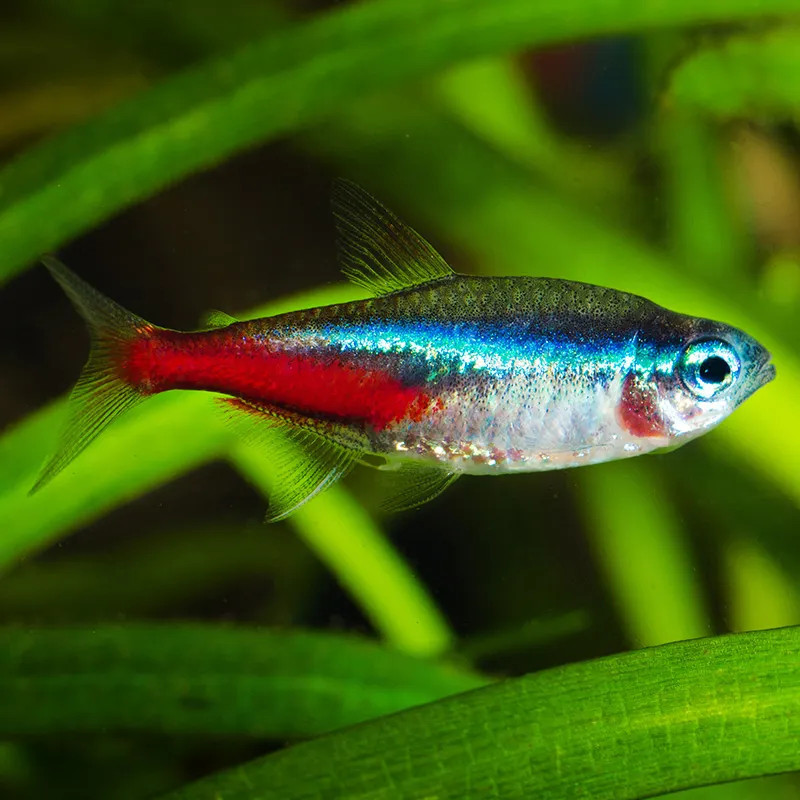Stocks Available
FLAME VON RIO
SKU:125943
HYPHESSOBRYCON FLAMMEUS
1 CM

Stock Available
Introduction • Common Name: Neon Tetra • Family: Characidae • Origin: Native to the tropical freshwater rivers and tributaries of South America, specifically in the Amazon Basin of Brazil, Colombia, and Peru. Physical Characteristics • Appearance: Neon Tetras are famous for their vibrant coloration. They have an iridescent blue-green horizontal stripe running from their nose to the adipose fin, complemented by a bright red stripe from the middle of their body to the tail. This combination of red and blue gives them a neon-like glow under aquarium lighting. • Size: They are a small species, growing up to 1.5 inches (4 cm) in length. • Lifespan: With proper care, Neon Tetras can live for 5 to 8 years in captivity. Habitat Requirements • Tank Size: A minimum tank size of 10 gallons is recommended for a small school, though larger tanks are ideal for accommodating a bigger group and providing more swimming space. • Water Conditions: o Temperature: They thrive in warmer water, ideally between 70-81°F (21-27°C). o pH: Neon Tetras prefer slightly acidic water, with a pH range of 6.0 to 7.0. o Water Hardness: Soft to slightly hard water is suitable, with a hardness range of 2 to 10 dGH. • Aquascaping: Neon Tetras enjoy a tank with plenty of hiding spots and shaded areas, created using plants, driftwood, and rocks. A dimly lit aquarium replicates their natural habitat, as they come from areas with low light penetration due to dense jungle canopies. Diet • Primary Diet: They are omnivorous and can be fed high-quality flake foods or micro pellets as a staple diet. • Supplemental Feeding: For optimal health and coloration, they benefit from live or frozen foods such as daphnia, brine shrimp, and bloodworms. • Feeding Frequency: Feed small portions 1-2 times per day to avoid overfeeding and maintain water quality. Behavior and Compatibility • Temperament: Neon Tetras are peaceful, shoaling fish that should be kept in groups of at least 6 to encourage natural behavior and reduce stress. In a group, they display synchronized swimming and vibrant color displays. • Suitable Tank Mates: They are excellent additions to community tanks and get along with other small, non-aggressive species like rasboras, Corydoras, and small tetras. They also pair well with shrimp and snails. • Incompatibilities: Avoid keeping them with larger, aggressive fish such as cichlids or large catfish, as these species may prey on them. Care Level • Difficulty: Neon Tetras are relatively hardy but sensitive to sudden changes in water parameters. Regular tank maintenance and stable conditions are key to keeping them healthy. • Maintenance: Weekly water changes of 20-25% are recommended, along with the use of a good filtration system to maintain water quality and clarity. Breeding • Reproduction: Neon Tetras are egg scatterers and will spawn in soft, slightly acidic water. A separate breeding tank with subdued lighting and plants is ideal for encouraging spawning. • Breeding Behavior: During spawning, females scatter their eggs, which the males fertilize. After spawning, remove the adults to prevent them from eating the eggs. • Fry Care: The eggs hatch within 24 hours, and the fry become free-swimming after about 4-5 days. They can be fed infusoria or liquid fry food, later transitioning to finely crushed flakes or baby brine shrimp. Health and Disease • Common Issues: Neon Tetras are prone to Neon Tetra Disease, which causes symptoms like loss of color and difficulty swimming. They can also be affected by common freshwater diseases such as ich and fin rot if kept in poor conditions. • Prevention: Maintaining stable water parameters, ensuring proper filtration, and providing a varied diet are essential to preventing diseases. Conservation and Sustainability • Wild Population: Although millions of Neon Tetras are collected from the wild each year, many available in the trade are now captive-bred. Wild populations in their native habitats remain stable but are monitored due to potential environmental changes. • Conservation Status: Neon Tetras are not currently listed as endangered, and captive breeding programs help ensure their sustainability in the aquarium trade. Conclusion The Neon Tetra is a dazzling, peaceful species that adds beauty and activity to any aquarium. Their hardy nature and ease of care make them a favorite among both beginner and experienced aquarists. By maintaining proper water conditions and providing a well-balanced diet, Neon Tetras will thrive and bring a vibrant touch to community tanks.
Data sheet
16 other products in the same category:
Customers who bought this product also bought: